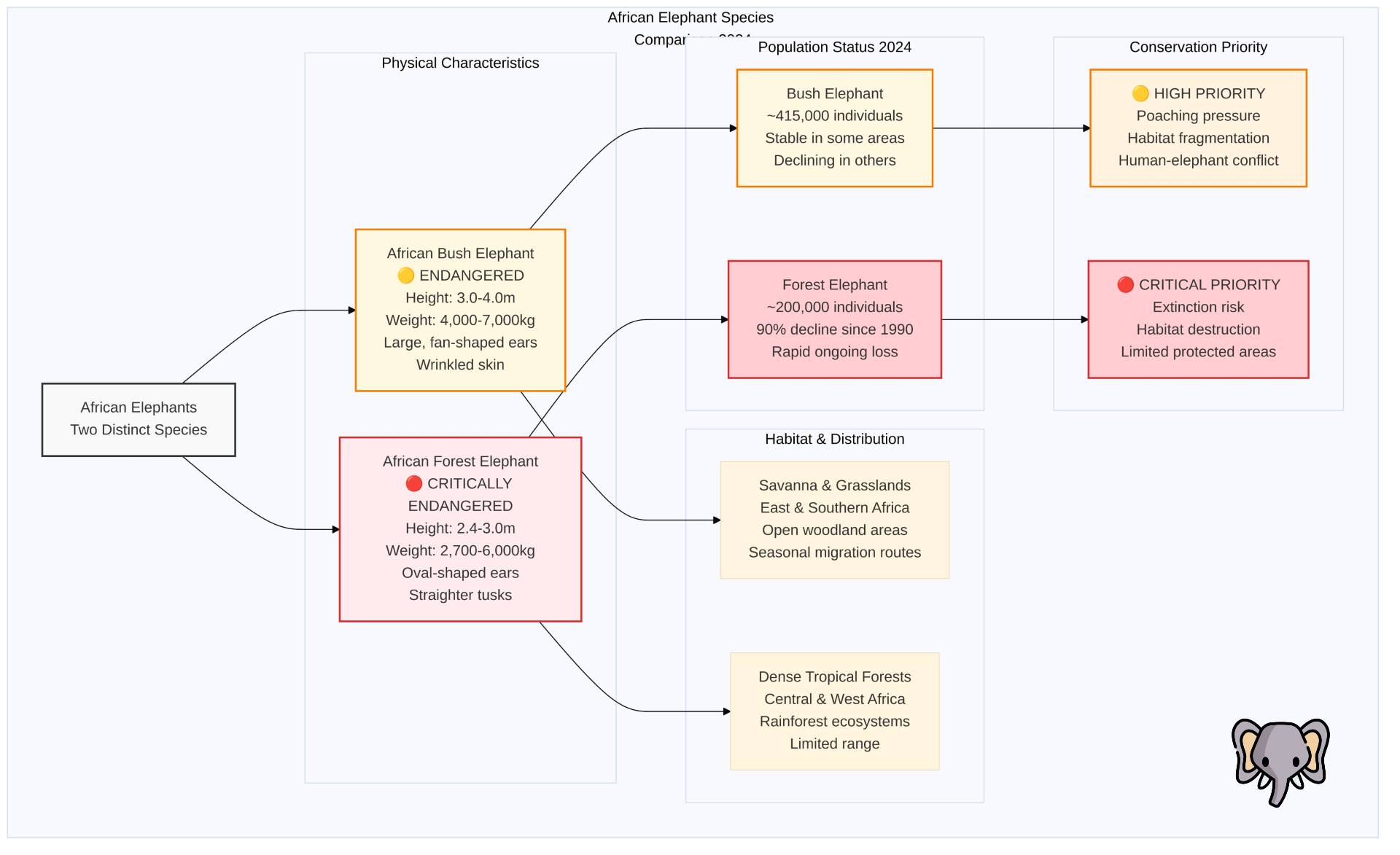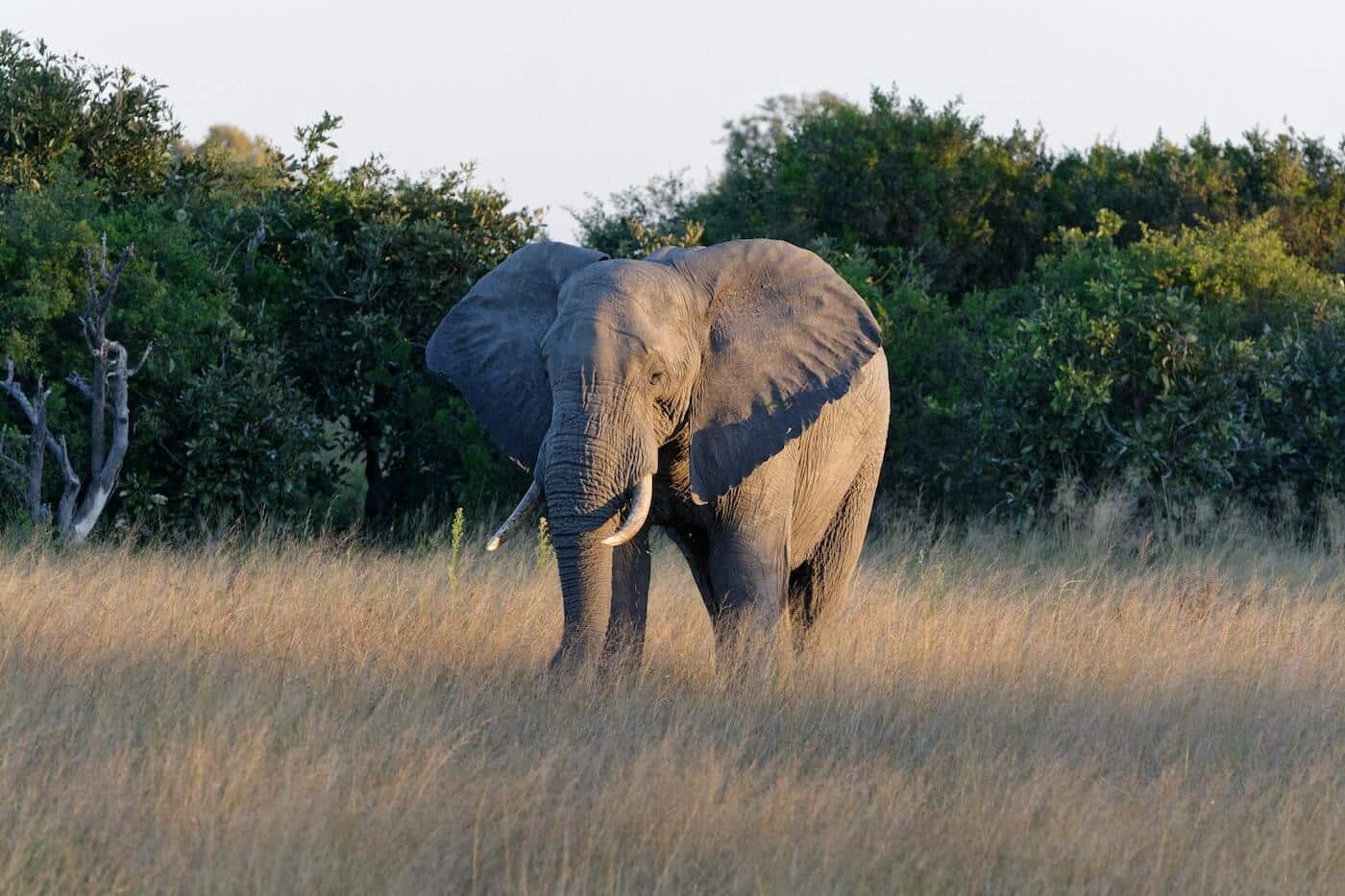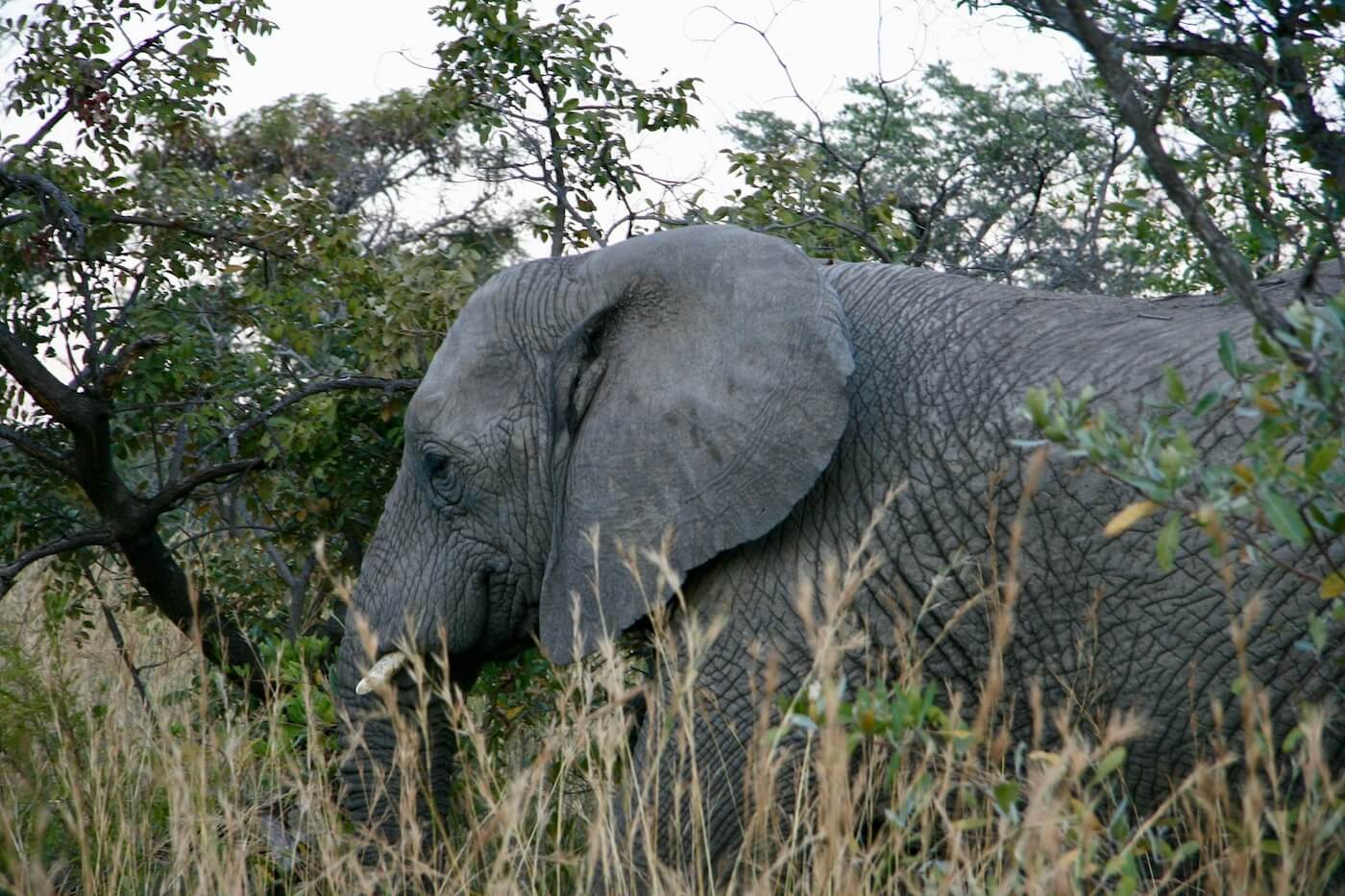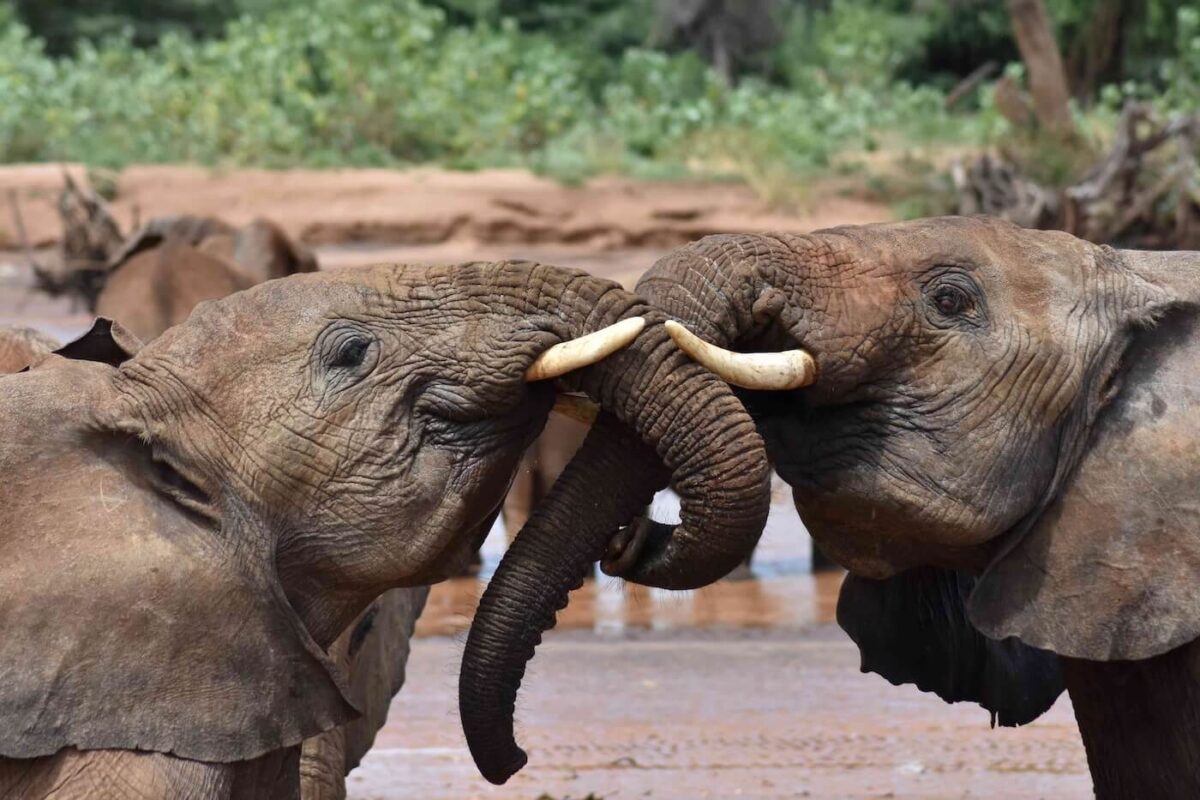Recent studies reveal a catastrophic 90% decline in forest elephant populations since 1990, highlighting the urgent need for species-specific conservation strategies.
For decades, scientists and wildlife enthusiasts viewed African elephants as a single species. However, groundbreaking genetic research has revealed that Africa is home to two distinct elephant species: the African bush elephant (Loxodonta africana) and the African forest elephant (Loxodonta cyclotis). This distinction, officially recognized by the IUCN in 2010, has revolutionized our understanding of elephant evolution, behavior, and conservation needs.
The differences between these two species extend far beyond their habitats. From the massive bush elephants roaming the savannas of East Africa to the smaller, more elusive forest elephants navigating the dense rainforests of Central and West Africa, each species has evolved unique characteristics that reflect millions of years of adaptation to their respective environments.
For wildlife enthusiasts planning African elephant viewing experiences, understanding these species differences is crucial for choosing destinations, timing visits, and appreciating the remarkable diversity within African elephant populations.
The seasonal patterns that govern elephant movements vary dramatically between species, making species-specific knowledge essential for successful wildlife viewing.

Species Recognition and Scientific Classification
The recognition of two distinct African elephant species represents one of the most significant developments in modern elephant research. This classification emerged from extensive genetic studies that revealed fundamental differences between bush and forest populations.
Genetic Evidence for Species Separation
Advanced DNA analysis has shown that African bush and forest elephants are as genetically distinct as Asian elephants are from mammoths.
Research published in Nature demonstrates that these species diverged approximately 2.6 million years ago, developing along separate evolutionary paths that resulted in distinct physical, behavioral, and ecological characteristics.
Key Genetic Findings:
- Chromosomal differences: Forest elephants have 28 chromosomes while bush elephants have 30
- Mitochondrial DNA: Distinct lineages indicating separate evolutionary histories
- Nuclear genome analysis: Confirms species-level genetic divergence
- Hybridization studies: Limited interbreeding in overlap zones produces sterile offspring
Dr. Alfred Roca, a geneticist at the University of Illinois who contributed to the landmark genetic studies, explains: “The genetic evidence clearly demonstrates that African bush and forest elephants represent distinct species that have been evolving separately for millions of years.”
Taxonomic History and Recognition
The path to species recognition involved decades of research and scientific debate:
Historical Classification (1900-2000): Both populations considered subspecies of Loxodonta africana Genetic Revolution (2000-2010): DNA studies reveal species-level differences Official Recognition (2010): IUCN formally recognizes two distinct species Conservation Impact (2010-present): Species-specific conservation strategies developed.

African Bush Elephant: Giants of the Savanna
African bush elephants (Loxodonta africana) represent the world’s largest land mammals, perfectly adapted for life in Africa’s vast savannas, grasslands, and semi-arid regions.
These magnificent animals embody the classic image of African elephants, with their impressive size and iconic silhouettes against the African sunset.
Physical Characteristics and Adaptations
Adult male bush elephants typically measure 3.0 to 4.0 meters (10 to 13 feet) at the shoulder and weigh between 4,000 to 7,000 kilograms (8,800 to 15,400 pounds).
The largest recorded bush elephant, shot in Angola in 1974, weighed an estimated 10,000 kilograms (22,000 pounds) and stood 4.2 meters (13.8 feet) at the shoulder.
Distinctive Features:
- Massive ears: Fan-shaped ears that can measure up to 2 meters in diameter
- Wrinkled skin: Deep skin folds that increase surface area for cooling
- Straight tusks: Both males and females typically develop tusks
- Concave back: Distinctive dipped back profile
- Trunk characteristics: Two finger-like projections at the trunk tip
Savanna Adaptations
Bush elephants have evolved numerous adaptations for life in open savanna environments:
Thermoregulation: Large ears and extensive skin folds help dissipate heat in hot, open environments where shade is limited.
Water Conservation: Efficient kidney function and behavioral adaptations allow survival in semi-arid conditions with limited water sources.
Feeding Strategies: Versatile feeding behavior allows exploitation of diverse plant resources, from grasses during wet seasons to bark and roots during dry periods.
Migration Patterns: Seasonal movements following rainfall and vegetation patterns, sometimes covering hundreds of kilometers annually.
Distribution and Habitat
Bush elephants inhabit a range of ecosystems across sub-Saharan Africa, with the largest populations concentrated in Eastern and Southern Africa.
Primary Habitats:
- Savannas and Grasslands: Open woodlands and grasslands of East Africa
- Semi-arid Regions: Kalahari Desert margins and similar environments
- Woodland Savannas: Mixed tree-grass ecosystems
- Floodplains: Seasonal wetlands and river systems
Current Range:
- Botswana: ~130,000 elephants (largest population)
- Zimbabwe: ~85,000 elephants
- Tanzania: ~60,000 elephants
- Kenya: ~35,000 elephants
- Zambia: ~27,000 elephants
Conservation Status and Population Trends
African bush elephants are classified as Endangered by the IUCN, with populations declining due to multiple threats. However, their conservation status varies significantly across their range.
Population Trends:
- Overall decline: 60% population reduction since 1979
- Regional variations: Some populations stable or increasing (Botswana, parts of Zimbabwe)
- Poaching impact: Estimated 20,000-30,000 elephants killed annually for ivory
- Habitat loss: Agricultural expansion reduces available habitat
Conservation Successes: The Kavango-Zambezi Transfrontier Conservation Area (KAZA) represents a major conservation success, protecting elephant migration routes across five countries and supporting the world’s largest elephant population.
Tourism and Viewing Opportunities
Bush elephants offer spectacular viewing opportunities across numerous African destinations. Understanding seasonal elephant viewing patterns enhances the likelihood of memorable encounters while supporting conservation through responsible tourism.
Premier Destinations:
- Botswana: Chobe National Park and Okavango Delta
- Tanzania: Serengeti and Tarangire National Parks
- Kenya: Amboseli and Tsavo National Parks
- Zimbabwe: Hwange National Park
- South Africa: Kruger National Park
Optimal Viewing Seasons:
- Dry Season (May-October): Elephants concentrate around water sources
- Migration Periods: Spectacular herds moving between seasonal ranges
- Calving Season (November-March): Opportunities to observe family dynamics


African Forest Elephant: The Rainforest Gardeners
African forest elephants (Loxodonta cyclotis) represent one of the world’s most endangered large mammals and play a crucial role as “ecosystem engineers” in Central and West African rainforests.
These smaller, more elusive elephants have evolved remarkable adaptations for life in dense forest environments.
Physical Characteristics and Forest Adaptations
Adult male forest elephants typically measure 2.4 to 3.0 meters (7.9 to 9.8 feet) at the shoulder and weigh between 2,700 to 6,000 kilograms (6,000 to 13,200 pounds).
While smaller than their savanna relatives, forest elephants possess unique adaptations that make them perfectly suited for rainforest life.
Distinctive Features:
- Smaller, oval-shaped ears: Better suited for navigation through dense vegetation
- Straighter, downward-pointing tusks: Adapted for forest floor foraging and defense
- Darker skin coloration: Provides camouflage in forest environments
- More rectangular body shape: Lower profile for moving through dense undergrowth
- Harder, denser bones: Structural adaptations for forest terrain
Ecological Role as Forest Gardeners
Forest elephants serve as crucial ecosystem engineers, shaping rainforest structure and biodiversity through their feeding and movement patterns.
Seed Dispersal: Forest elephants disperse seeds from over 350 plant species, traveling up to 60 kilometers before depositing seeds in nutrient-rich dung. This long-distance dispersal is essential for maintaining genetic diversity in forest plant populations.
Forest Structure: Elephant feeding creates clearings and maintains forest paths that benefit numerous other species. Their selective browsing influences forest composition and succession patterns.
Carbon Storage: By promoting the growth of large, slow-growing trees through selective feeding, forest elephants contribute to carbon sequestration in tropical forests.
Dr. Andrea Turkalo, who studied forest elephants at Dzanga Bai for over 20 years, observes: “Forest elephants are the architects of the rainforest. Their disappearance would fundamentally alter these ecosystems in ways we’re only beginning to understand.”
Critical Conservation Status
Forest elephants face an extinction crisis, with populations declining by over 90% since 1990. The species is classified as Critically Endangered, representing one of the most severe conservation emergencies among large mammals.
Catastrophic Decline Factors:
- Poaching Crisis: High-value ivory drives intensive poaching pressure
- Habitat Destruction: Logging and agricultural conversion destroy forest habitat
- Civil Conflict: Political instability in range countries hampers conservation efforts
- Low Reproductive Rate: Slow breeding makes population recovery extremely difficult
Recent Population Studies: A comprehensive 2024 study published in Conservation Biology documented the extent of forest elephant decline:
- Central African Republic: 95% population decline since 1990
- Cameroon: 80% decline in major forest reserves
- Gabon: 70% decline despite protected area status
- Democratic Republic of Congo: Populations fragmented and critically low
Remaining Strongholds
Despite the crisis, several areas maintain viable forest elephant populations:
Key Conservation Areas:
- Sangha Trinational (Cameroon/CAR/Congo): UNESCO World Heritage site
- Odzala-Kokoua National Park (Congo): Large intact forest ecosystem
- Lopé National Park (Gabon): Mixed forest-savanna habitat
- Dzanga-Sangha (Central African Republic): Famous for forest clearings
Conservation Efforts and International Response
The forest elephant crisis has prompted unprecedented international conservation efforts:
Anti-Poaching Initiatives: Wildlife Conservation Society leads anti-poaching efforts across Central Africa, training local rangers and providing equipment for elephant protection.
Habitat Protection: WWF supports the creation and management of transboundary protected areas that preserve critical forest elephant habitat.
Community Engagement: Local communities receive training and employment in conservation activities, creating economic incentives for elephant protection.
International Trade Controls: CITES regulations aim to reduce ivory demand, though enforcement remains challenging.
Limited Tourism Opportunities
Forest elephant viewing opportunities are limited but provide unique experiences for dedicated wildlife enthusiasts:
Recommended reading: The Best Destinations in the World to see Elephants in the wild
Viewing Locations:
- Dzanga Bai (CAR): Forest clearing where elephants gather to access minerals
- Langoué Bai (Gabon): Remote forest clearing accessible by boat
- Odzala (Congo): Guided forest walks and bai visits
Viewing Challenges:
- Dense vegetation: Limited visibility in forest environments
- Elusive behavior: Forest elephants are more wary of humans
- Access difficulties: Remote locations require specialized logistics
- Security concerns: Political instability affects some range areas
Species Comparison: Understanding the Differences
The differences between African bush and forest elephants extend across multiple biological and ecological dimensions, reflecting millions of years of separate evolution.
Physical Comparison Table
| Characteristic | Bush Elephant | Forest Elephant |
|---|---|---|
| Height (males) | 3.0-4.0m (10-13 ft) | 2.4-3.0m (7.9-9.8 ft) |
| Weight (males) | 4,000-7,000 kg | 2,700-6,000 kg |
| Ear Shape | Large, fan-shaped | Smaller, oval-shaped |
| Tusk Direction | Curved outward | Straight, downward |
| Skin Color | Lighter gray | Darker gray-brown |
| Body Profile | Concave back | More rectangular |
Behavioral and Ecological Differences
Social Structure:
- Bush elephants: Large herds of 8-100 individuals
- Forest elephants: Smaller groups of 2-8 individuals
Feeding Behavior:
- Bush elephants: Grazers and browsers, seasonal diet variation
- Forest elephants: Primarily browsers, fruit specialists
Movement Patterns:
- Bush elephants: Long-distance seasonal migrations
- Forest elephants: Smaller home ranges, forest path networks
Communication:
- Bush elephants: Long-distance infrasonic calls across open landscapes
- Forest elephants: Adapted calls for forest acoustic environments
Conservation Implications
The recognition of two distinct species has profound implications for conservation strategies:
Species-Specific Threats:
- Bush elephants: Habitat fragmentation, human-wildlife conflict
- Forest elephants: Intensive poaching, habitat destruction
Conservation Priorities:
- Bush elephants: Corridor protection, community coexistence
- Forest elephants: Anti-poaching, habitat preservation
Funding Allocation:
- Bush elephants: Population management, tourism development
- Forest elephants: Emergency intervention, law enforcement
Planning Your African Elephant Experience
Understanding species differences enhances wildlife viewing experiences and supports conservation through informed tourism choices.
Choosing Your Destination
For Bush Elephant Viewing:
- Best overall experience: Botswana (Chobe/Okavango)
- Great migration: Tanzania (Tarangire/Serengeti)
- Photography opportunities: Kenya (Amboseli)
- Budget-friendly: South Africa (Kruger)
For Forest Elephant Viewing:
- Most accessible: Gabon (Lopé National Park)
- Unique experience: CAR (Dzanga Bai) – when security permits
- Research opportunities: Congo (Odzala-Kokoua)
Seasonal Considerations
Bush Elephant Optimal Times:
- Dry season (May-October): Concentrated around water sources
- Early dry season (May-July): Best weather conditions
- Late dry season (August-October): Highest elephant densities
Forest Elephant Considerations:
- Dry season (December-March): Better access to forest clearings
- Wet season (April-November): More challenging but authentic experience
Conservation Outlook and Future Challenges
The future of African elephants depends on addressing species-specific conservation challenges while maintaining the ecological integrity of their respective habitats.
Bush Elephant Conservation Priorities
Habitat Connectivity: Protecting migration corridors and seasonal ranges across international boundaries remains crucial for maintaining viable bush elephant populations.
Human-Wildlife Conflict: Developing sustainable coexistence strategies as human populations expand into traditional elephant ranges.
Tourism Balance: Managing tourism pressure while maximizing conservation benefits and community support.
Forest Elephant Emergency Response
Anti-Poaching Intensification: Immediate action required to stop the poaching crisis before forest elephant populations collapse entirely.
Habitat Protection: Preserving remaining intact forest ecosystems and creating protected corridors between fragmented populations.
International Cooperation: Coordinated efforts across range states to address transboundary conservation challenges.
Climate Change Implications
Both species face additional challenges from climate change:
Bush Elephants: Changing rainfall patterns may alter traditional migration routes and water availability.
Forest Elephants: Shifting forest composition and structure could affect food resources and habitat suitability.
Conclusion: Two Species, One Conservation Mission
The recognition of African bush and forest elephants as distinct species has revolutionized our understanding of elephant diversity and conservation needs.
While bush elephants face significant challenges, their populations remain relatively stable in some regions. Forest elephants, however, face an immediate extinction crisis that demands urgent global action.
For wildlife enthusiasts, understanding these species differences enhances appreciation for elephant diversity and supports more informed conservation choices. Whether witnessing the spectacular gatherings of bush elephants in Botswana’s Chobe National Park or experiencing the rare privilege of observing forest elephants in Central African rainforests, each encounter contributes to the broader mission of elephant conservation.
The future of both species depends on our collective commitment to protecting their habitats, supporting local communities, and addressing the underlying drivers of elephant decline. Through responsible tourism, conservation support, and continued research, we can ensure that future generations will have the opportunity to witness the majesty of both African elephant species in their natural habitats.
As we continue to learn about these remarkable animals, one thing remains clear: the diversity of African elephants reflects the incredible adaptability and resilience of life on Earth. Protecting both species is not just about preserving individual populations—it’s about maintaining the ecological integrity of Africa’s most important ecosystems and honoring our responsibility as stewards of the natural world.
